Sweet Corn
IPM Program personnel are finished deploying black light traps and nearing completion of the corn earworm (CEW) pheromone trap network in New Jersey. Limited collections from traps thus far have captured one corn earworm (CEW) from Chester in Morris County. We anticipate only limited CEW and European corn borer (ECB) moths for the near term, and as numbers increase, look for population maps of ECB, CEW, brown marmorated stink bug (BMSB). The resulting full-state maps will include interpretive information.
Allium leaf miner
Captures of allium leaf miner (ALM) adults on sticky cards continue to decline.
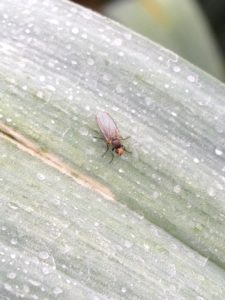 Cards from chive plantings in Mercer and Hunterdon counties have captured 6 and 0 flies/week respectively for the week ending 5/11/22. This is the second week with no catch in the Hunterdon County chive field. Our peak period for adult activity appears to have been the week ending 4/21/22, when catches in Mercer and Hunterdon counties were 27 and 45 respectively. The rate of decline in catches, and the time of year are strong indications that this first flight is in it’s last days, and may be over in some areas. It is unlikely that significant new injury will occur now, but should growers opt to apply insecticides, recommended materials for ALM management include:
Cards from chive plantings in Mercer and Hunterdon counties have captured 6 and 0 flies/week respectively for the week ending 5/11/22. This is the second week with no catch in the Hunterdon County chive field. Our peak period for adult activity appears to have been the week ending 4/21/22, when catches in Mercer and Hunterdon counties were 27 and 45 respectively. The rate of decline in catches, and the time of year are strong indications that this first flight is in it’s last days, and may be over in some areas. It is unlikely that significant new injury will occur now, but should growers opt to apply insecticides, recommended materials for ALM management include:
Spinosyn materials (Radiant, Entrust (OMRI approved)), pyrethroids (Mustang Maxx, Warrior), neonicotinoids (Scorpion, Venom) and the insect growth regulator Trigard are labeled for miner control. The diamide, Exirel, is permitted in NJ under a (section 2ee recommendation) as well.
Cole crops
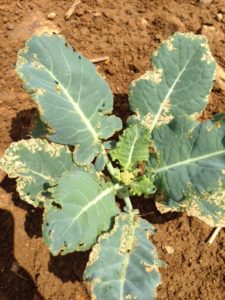 Recently transplanted crops of broccoli, cabbage, etc. as well as newly emerged seedlings are at risk of damage from flea beetles (see photo at left). Flea beetle activity occurs primarily on warm, still days. Inspect plantings under these fair conditions to get an accurate assessment of population in the field. Flea beetles can do considerable damage to small plants, and have a
Recently transplanted crops of broccoli, cabbage, etc. as well as newly emerged seedlings are at risk of damage from flea beetles (see photo at left). Flea beetle activity occurs primarily on warm, still days. Inspect plantings under these fair conditions to get an accurate assessment of population in the field. Flea beetles can do considerable damage to small plants, and have a 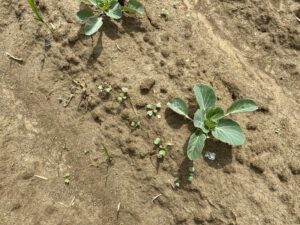 preference for the “hotter” flavored crops like arugula and mustard. They will feed on all brassicas however, and broccoli and Tuscan kale are also favored hosts. Site rotation is critical to managing flea beetle populations because they can build to high numbers in the repeated presence of host crops or host weeds (see photo at right – cabbage transplants with brassica weeds). Scout early and consider treating when 50% or more plants are showing injury and flea beetles are present on plants. Respond quickly to limit injury. Systemic insecticides such as the neonicotinoid (IRAC 4A) class, used at planting, can provide protection from flea beetles for the first critical weeks. Check the Cole Crops section of the 2022/23 Commercial Vegetable Production Guide for a complete list of insecticide recommendations.
preference for the “hotter” flavored crops like arugula and mustard. They will feed on all brassicas however, and broccoli and Tuscan kale are also favored hosts. Site rotation is critical to managing flea beetle populations because they can build to high numbers in the repeated presence of host crops or host weeds (see photo at right – cabbage transplants with brassica weeds). Scout early and consider treating when 50% or more plants are showing injury and flea beetles are present on plants. Respond quickly to limit injury. Systemic insecticides such as the neonicotinoid (IRAC 4A) class, used at planting, can provide protection from flea beetles for the first critical weeks. Check the Cole Crops section of the 2022/23 Commercial Vegetable Production Guide for a complete list of insecticide recommendations.
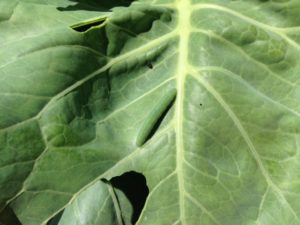 Low levels of imported cabbageworm (ICW at left) are starting to appear in cole crop plantings in central NJ, and adults are evident everywhere. With warmer temperatures on the way, these infestations should increase rapidly. Check 5 consecutive plants each in 10 random locations throughout the planting, paying particular attention to the innermost leaves where ICW often feed (see photo at lower right). Consider treating if caterpillars are found on 10% or more plants that are in the 0-9 true leaf stage. From 9-leaf to the early head stage (in broccoli, cauliflower, and cabbage) infestations up to 20% may be tolerated. Once heads begin to form, a 5% threshold should be observed to protect the marketable portion of
Low levels of imported cabbageworm (ICW at left) are starting to appear in cole crop plantings in central NJ, and adults are evident everywhere. With warmer temperatures on the way, these infestations should increase rapidly. Check 5 consecutive plants each in 10 random locations throughout the planting, paying particular attention to the innermost leaves where ICW often feed (see photo at lower right). Consider treating if caterpillars are found on 10% or more plants that are in the 0-9 true leaf stage. From 9-leaf to the early head stage (in broccoli, cauliflower, and cabbage) infestations up to 20% may be tolerated. Once heads begin to form, a 5% threshold should be observed to protect the marketable portion of 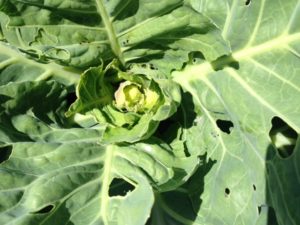 the plant. For leafy greens such as collards and kale, 10% plants infested is the threshold throughout.
the plant. For leafy greens such as collards and kale, 10% plants infested is the threshold throughout.
Although none have been detected in scouted fields yet, diamondback moth larvae (DBM) should make their appearance soon. Remember that some populations of DBM are resistant to carbamate and synthetic pyrethroid insecticides. This pest has a history of developing resistance to newer chemistries as well. The lack of DBM control with certain insecticides has been noted in NJ previously. It is important to distinguish between common cole crop pests for this reason. DBM larvae grow to a length of approximately 0.5”, and taper toward both ends (see photo at lower right).  These caterpillars thrash violently when disturbed. ICW grow to a length of approximately 1.25” and are covered with short hairs. Some chemistries that specifically target caterpillar pests have been effective against DBM as well as all other caterpillar pests of cole crops. These materials include (active ingredient – trade name (IRAC* code)):
These caterpillars thrash violently when disturbed. ICW grow to a length of approximately 1.25” and are covered with short hairs. Some chemistries that specifically target caterpillar pests have been effective against DBM as well as all other caterpillar pests of cole crops. These materials include (active ingredient – trade name (IRAC* code)):
Spinosad/Spinetoram – Entrust (OMRI)/ Radiant (5)
Chlorantraniliprole – Coragen (28)
Cyantraniliprole – Exirel (28)
It is important to check fields approximately 24 hours after an insecticide application. Live DBM on foliage after 24 hours is an indication that there may be resistance to the applied material. An exception to this are the B.t. products, such as Dipel, Xentari, Javelin, etc. These materials cause damage to the caterpillars’ gut membrane and do not kill quickly.

